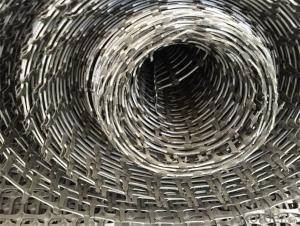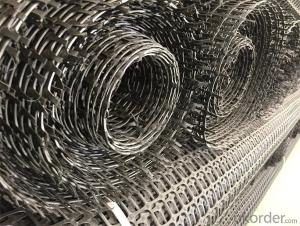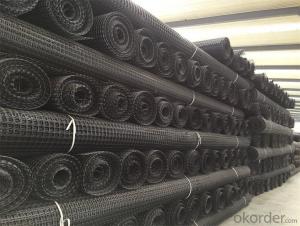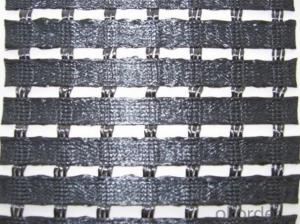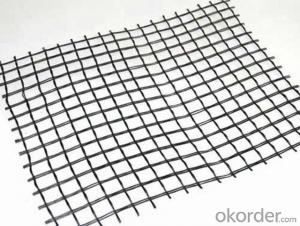Reinforcement Geogrid in Civil Engineering Construction
- Loading Port:
- China main port
- Payment Terms:
- TT OR LC
- Min Order Qty:
- 1000 m²
- Supply Capability:
- 10000000 m²/month
OKorder Service Pledge
OKorder Financial Service
You Might Also Like
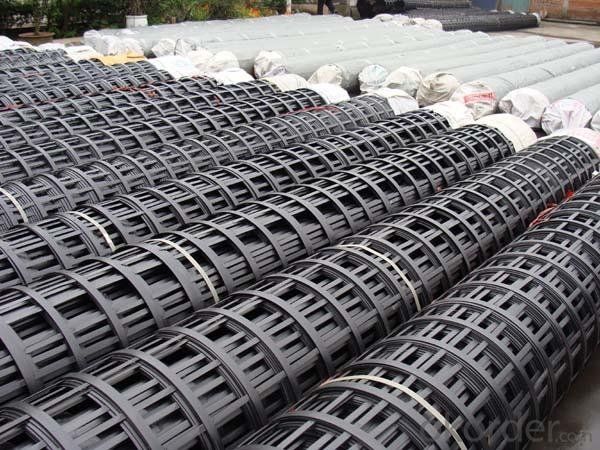
Introduction
1)fiberglass geogrid with CE certificate
2)Materials:fiberglass
3) Tensile strength:MD/CD:30 ~ 200kn/m
4)WIdth:1 ~ 6m
Temperature Resistance (Centigrade): -100~290
Surface Processing: Modified asphalt or Polymer and self adhesive
Packing: With PE bags
WEIGHT
300G/SQM
500G/SQM
ELONGATION AT BREAK
3%
3%
TENSILE STRENGTH IN KNOT
5KN/M
10KN/M
WIDTH:
1--6M
1--6M
Fiberglass geogrid is a kind of new favorable earthwork base material to strengthen the road surface and roadbed. This product is composed of fiberglass filaments that are coated with an inorganic sizing agent
Our Service
Quality assurance
1.On a regular basis or as per your request,we entrust national testing agencies to conduct quality inspections
2. Strictly in accordance with the ISO9001-2008 international quality system standard,we monitor and manage the whole process throughout production,quality testing,and measurement to ensure product quality
3. For quality-related construction delay or substandard construction(except for damage or losses due to customer’s responsibility or irresistible natural disasters),we have refunding,replacement,and repair services.We will respond to customers’ feedbacks on quality issues within 24 hours.
Packaging & Shipping
Packing: PLASTIC FILM INSIDE, AND WOVEN BAG OUTSIDE
Shipping: About 15 days after receipt the deposit
FAQ:
Q: What kind of payments does jenor support?
A: T/T, L/C, Cash are accepted.
Q: Do you charge for the samples?
A: Accordeing to our company policy, the samples are free, we only charge the freight fee. And we will return the freight fee during the next order.
Q: Can you produce according to customers' design?
A: Sure, we are professional manufacturer, OEM and ODM are both welcome.
Q: Do you have other products?
A: Yes, please check the pictures:
- Q:How do geogrids help in reducing the risk of pavement rutting?
- Geogrids help in reducing the risk of pavement rutting by improving the structural integrity of the pavement. They are placed within the pavement layers to distribute the load more evenly, increasing the pavement's resistance to deformation and rutting. The geogrids create a reinforced layer that enhances the load-bearing capacity and stability of the pavement, preventing the formation of ruts and prolonging its lifespan.
- Q:How do geogrids help in reducing the risk of foundation settlement?
- Geogrids help in reducing the risk of foundation settlement by providing reinforcement and stability to the soil. They distribute the load from the foundation evenly, preventing excessive settlement or shifting of the soil. This helps to maintain the structural integrity of the foundation and minimize the potential for settlement-related damage.
- Q:Can geogrids be used in shoreline erosion control projects?
- Yes, geogrids can be used in shoreline erosion control projects. Geogrids are commonly used to reinforce and stabilize soils, including those found in coastal areas. They can help prevent erosion by providing strength and stability to the soil, reducing surface runoff, and enhancing vegetation growth.
- Q:How do geogrids reduce the amount of fill required for construction?
- Geogrids reduce the amount of fill required for construction by providing reinforcement and stability to the soil, allowing for a steeper slope or thinner layer of fill to be used. This is achieved through the interlocking design of the geogrid, which distributes the load more evenly, minimizing settlement and preventing soil movement.
- Q:High density polyethylene one-way geogrid, tensile yield of 20kn/m
- Material is high density polyethylene material
- Q:How to shop on the road surface of the two
- The earthwork room is paved on the road with two products linked to each other
- Q:Are geogrids suitable for reinforcing railway subgrades?
- Yes, geogrids are suitable for reinforcing railway subgrades. Geogrids provide effective soil stabilization, improve load-bearing capacity, and reduce settlement, making them an ideal solution for reinforcing railway subgrades and ensuring long-term performance and stability of the tracks.
- Q:How do geogrids improve the performance of geocell-reinforced retaining walls?
- Geogrids enhance the performance of geocell-reinforced retaining walls by providing additional tensile strength and stability. They act as a reinforcement layer within the geocell structure, preventing soil movement and enhancing load distribution. This combination increases the overall strength of the retaining wall, allowing it to withstand higher loads and maintain structural integrity over time.
- Q:How do geogrids enhance the stability of steep slopes?
- Geogrids enhance the stability of steep slopes by providing reinforcement and increasing the tensile strength of the soil. They act as a barrier, distributing the load and preventing soil erosion. This reinforcement helps to prevent slope failure and ensures the long-term stability of the slope.
- Q:What are the factors that affect the installation time of geogrids?
- There are several factors that can affect the installation time of geogrids. First and foremost, the size and complexity of the project play a significant role. Larger and more complex projects may require more time for planning, preparation, and execution. The type and condition of the soil also impact installation time. Soft or loose soils may require additional stabilization measures before the geogrids can be installed, which can extend the overall installation duration. Similarly, rocky or hard soils may require specialized equipment or techniques, which can also increase the installation time. The availability and accessibility of the site can also affect installation time. If the site is difficult to reach or has limited space for equipment and materials, it can slow down the installation process. Additionally, factors such as weather conditions, environmental restrictions, and safety considerations can further influence the installation time. Lastly, the experience and expertise of the installation team can greatly impact the efficiency and speed of the installation process. A skilled and experienced team can streamline the installation and overcome any challenges more effectively, reducing the overall installation time.
1. Manufacturer Overview |
|
|---|---|
| Location | |
| Year Established | |
| Annual Output Value | |
| Main Markets | |
| Company Certifications | |
2. Manufacturer Certificates |
|
|---|---|
| a) Certification Name | |
| Range | |
| Reference | |
| Validity Period | |
3. Manufacturer Capability |
|
|---|---|
| a)Trade Capacity | |
| Nearest Port | |
| Export Percentage | |
| No.of Employees in Trade Department | |
| Language Spoken: | |
| b)Factory Information | |
| Factory Size: | |
| No. of Production Lines | |
| Contract Manufacturing | |
| Product Price Range | |
Send your message to us
Reinforcement Geogrid in Civil Engineering Construction
- Loading Port:
- China main port
- Payment Terms:
- TT OR LC
- Min Order Qty:
- 1000 m²
- Supply Capability:
- 10000000 m²/month
OKorder Service Pledge
OKorder Financial Service
Similar products
New products
Hot products
Related keywords

